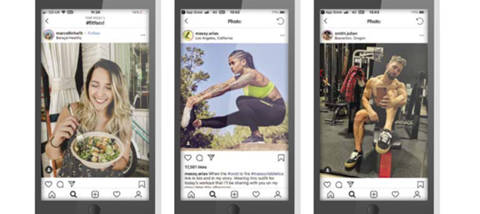
If Christmas is a time for celebration, spending time with family and a little overindulgence, then January is the time for health and fitness. Last year the most popular New Year’s resolution was “exercise more” (59 per cent), followed by “eat healthier” (53 per cent) – then after saving money came “lose weight” (48 per cent), according to a YouGov poll.
It’s easier than ever to ride the wellness train; a surge in interest in being health conscious has seen the growth of a social phenomenon known as ‘influencers’. These are people using social media channels such as Instagram and YouTube to reach new audiences with their ideas and products. The world of wellness, is no longer limited to protein powder for musclemen or Lycra for aerobics addicts. Today, what seems to count is developing the fittest, hottest and healthiest image that you can achieve, and letting as many people as possible know about it via the internet.
Ever heard of Michelle Lewin? How about Massy Arias? Kayla Itsines? Julian Michael Smith? They are some of the new generation of so-called influencers who produce stylish pictures of their super-healthy habits, along with videos of their perfectly toned physiques being exercised still further. Their online followers are in the millions and they’re reported to earn similar amounts from advertising deals: to simply mention a product in a post on social media, some can earn as much as $750,000.
These influencers have inspired a legion of imitators who are desperate to get famous and become the next most popular Instagram account. Are they all just wanting to keep fit and let the world know about it? Or are they just sharing images of physical perfection for the affirmation that comes from their thousands of ‘likes’? It might be hard to tell with the mixed motivations that drive social media. Check out #fitnessmotivation on Instagram and you can judge for yourself. There are millions of pictures of people working on their toned physiques, and working even harder to make their pictures look good and get you to notice them.
My story
For a time, I found these Instagram accounts helpful on my journey from being fitness phobic to my current status as ‘health freak’ (as I was recently called). Most of my life I steadfastly avoided anything healthy (before I became a Christian, my New Year’s resolutions included stopping smoking). But after developing a disabling health condition, and following a few years of suffering, I finally got motivated to prioritise my health. Now, more than five vegetables a day isn’t unusual. I’m low-carb as it reduces my migraines and I exercise about three times a week. I have muscles where there has never before been any muscles, and when my illness leaves me alone, my energy levels are through the roof. These positive effects spurred me on, but, when motivation flagged, I turned to Instagram. From pictures of bowls brimming with vibrant multicoloured salads (see #cleaneating) to videos of impossible-looking #Pilates and #calisthenics (impressive body movements), I found that Instagram’s new generation of health and fitness gurus inspired me to buy vegetables, get off the sofa and get moving. For their role in improving my health I’ve got to be grateful.
They’ve also played a role in increasing interest in health and fitness more generally. “Living an active lifestyle, regularly exercising, and healthy eating have become ‘trendy’, and accordingly, sharing fitness-related content has a massive digital following and engagement around the world,” Laura DiBiase, a marketing manager in the fitness industry, wrote in a blog for Sotrender. She says fitness influencers have used Facebook, Instagram and YouTube to become “international celebrities”, while nutrition and athletic clothing companies have “created armies of loyal followers”. This has to be all good, right? What can be wrong with inspiring people towards better health?
Psychologists have found that the more selfies you post, the more narcissistic you are
Perhaps it was good for me, but then I’m a woman of a certain age, and I went through the insecurities of adolescence well before there was even an internet dial-up connection. When the TV had four or five channels and all our phones were attached to the wall, our sources of inspiration for health were very different.
If you can remember the spandex-clad ‘Mr Motivator’ and diet-and-keep-fit guru Rosemary Conley, then you had a more down-to-earth introduction to health and fitness than today’s teenagers. Yes, these exercise fanatics had great physiques that were the envy of anyone who wobbled, but they still looked like normal people you might see down your local shop. Their kind of fitness was attainable; it just required effort and exercise. And our exposure to their toned torsos was very limited – just an energetic routine on morning telly and a few exercise videos (watched on VHS).
Today’s Instagram influencers are very different. This horde of fitness fanatics each produces several daily shots and videos, every one of them obsessively engineered to look as appealing as possible. The images go way beyond the exercise videos of yesteryear, and display perfect bodies in perfect poses, as photogenic and as stylised as they can get. These images are what the younger generation is shown when they’re learning about health, and this can’t be good for anyone’s self-image or understanding of physical wellbeing.
Pursuing perfection
On social media, there’s intense competition for ‘likes’ that force the influencers to post more extreme videos and more airbrushed images. The multitudes of impressive physiques that we see when we type in “#fitness” have been intensely curated and manipulated to look as visually appealing as possible. Inevitably, many of the photos become semi-pornographic and go well beyond fitness inspiration into titillation.
For younger generations airbrushed images and videos of supposedly perfect lives is all they've known
Influencers are under a lot of pressure to do this. Their Instagram accounts earn them self-esteem as well as income. Oenone Forbat, a fitness influencer (125k followers), admitted in an article for Woman’s Health that being on social media gave her a ‘fix’: “To have my face, body and words appreciated by thousands of strangers and even acquaintances?...It was a thrill; one that I’m sad to say now felt more validating than a high grade or an affectionate comment from a loyal friend.”
People are beginning to realisethat bodies like these are not onlyunachievable, they are also not real. Pilates teacher Cassey Ho, who is a YouTube and Instagram favourite under the name ‘Blogilates’ has helped re-educate us, with her pictures showing the difference between ordinary images and those doctored to remove imperfections (see below). In the unaltered photos, she looks just like an ordinary woman with a good figure. In the photoshopped images, she looks impossibly svelte and her face has been manipulated to look perfectly plastic. The former is a healthy inspiration for those who want to get fit; the latter is an artificial avatar designed to stand out from the enormous crowd of fitness images on social media.
Psychologists are only just beginning to investigate social media and its effect on our wellbeing and our society. It has been blamed for everything, from the bitter divides over Brexit and political intolerance to the worsening mental health of our younger generations. There are certainly some worrying signs from early studies. Psychologist shave found that the more selfies you post, and the more time you’re on Instagram, the more narcissistic you are – a measure of being self-absorbed and lacking empathy for others – not very good qualities from a spiritual point of view. Does Instagram make people more selfish, or do narcissistic people post more on Instagram? It’s hard to say, but there’s no doubt there’s a problem.
Forbat admits: “Not only can influencers become micro-celebrities in their own right, they can edit, filter and curate their content; opportunities that, when you think about it, are forms of manipulation, control and deceit – all examples of narcissistic tendencies.” If we’re not careful, people who become famous on social media are rewarded for what is really damaging and dysfunctional behaviour, not least for themselves.
Social media doesn't tend to bring out my best qualities
This tendency can come back to bite these wannabe celebrities too. When influencer Tatiele Polyana posted a glamorous picture of herself on a beach in a post about a hurricane in the Bahamas, she received a lot of criticism for the apparent self-promotion in the face of tragedy. But is what she did much different from the daily churning out of posts hungry for likes? It might expose the self-absorption more starkly, but it’s not much different in terms of the underlying motivations that drive many people to post on social media.
Influencers are aware that the more popular they are, the more money they can earn, as advertisers are keen to get their goods promoted on their feeds. “We actually believe influencers are more impactful than athletes and TV stars because they are more relatable and so their audience is more tapped in,” said Joe Gagliese in an interview for Vox, (Joe runs an‘ influencer agency’, Viral Nation).“So it’s like, why pay a celebrity $50million for a deal when that can be split up among influencers and make real impact?”
Social media and psychology
Health and fitness is no longer about wanting to get our bodies in good shape so we can avoid ill health and feel more energised, it’s a search for perfection: impossible glamour and a flawless physique.
Most concerning is the younger generation, which has little experience of anything else. The competition for ‘likes’, the airbrushed images, the videos of supposedly perfect lives is all they’ve known.
I found the Instagram feeds to be inspiring; but then I was a (relatively) mature adult, and I was lucky enough to have a relationship with God that gave me self-worth and the love and approval that humans need. I am blessed to be able to see my body as God’s gift, no more than a vehicle for my soul, that needs good fuel and a bit of tuning to stop it malfunctioning. Fitness isn’t my priority, but, if I was younger and I didn’t have Jesus, I can’t say how #fitnessmotivation would have affected how I viewed myself.
Even so, social media doesn’t usually bring out my best qualities; a problem that seems to be shared by almost everyone on it. After a lot of reflection I have decided that for now I’m off Facebook, I rarely venture onto Instagram and I approach Twitter while holding my nose.
I can choose to avoid the pitfalls of social media, but it’s having an enormous influence on the world around us, one that’s even more significant for the younger generations. Let’s examine and question this while we still can.
































